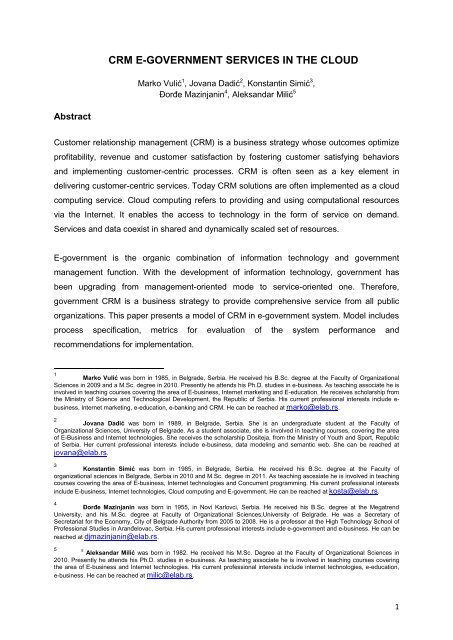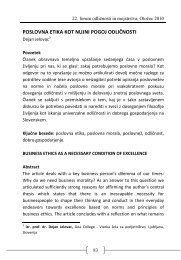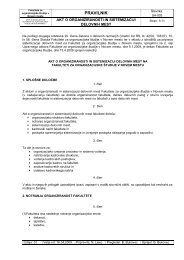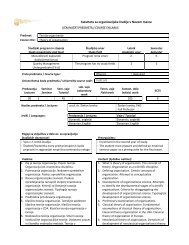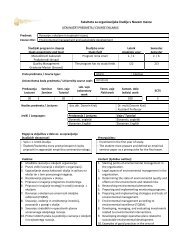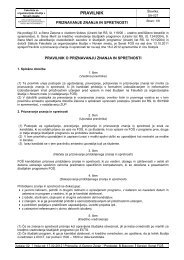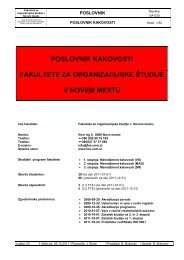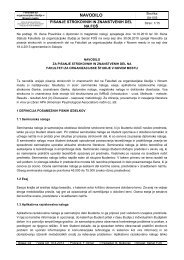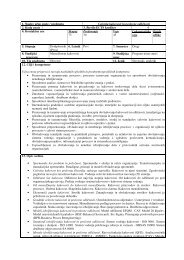CRM e-government services in the cloud
CRM e-government services in the cloud
CRM e-government services in the cloud
You also want an ePaper? Increase the reach of your titles
YUMPU automatically turns print PDFs into web optimized ePapers that Google loves.
Abstract<br />
<strong>CRM</strong> E-GOVERNMENT SERVICES IN THE CLOUD<br />
Marko Vulić 1 , Jovana Dadić 2 , Konstant<strong>in</strong> Simić 3 ,<br />
Đorđe Maz<strong>in</strong>jan<strong>in</strong> 4 , Aleksandar Milić 5<br />
Customer relationship management (<strong>CRM</strong>) is a bus<strong>in</strong>ess strategy whose outcomes optimize<br />
profitability, revenue and customer satisfaction by foster<strong>in</strong>g customer satisfy<strong>in</strong>g behaviors<br />
and implement<strong>in</strong>g customer-centric processes. <strong>CRM</strong> is often seen as a key element <strong>in</strong><br />
deliver<strong>in</strong>g customer-centric <strong>services</strong>. Today <strong>CRM</strong> solutions are often implemented as a <strong>cloud</strong><br />
comput<strong>in</strong>g service. Cloud comput<strong>in</strong>g refers to provid<strong>in</strong>g and us<strong>in</strong>g computational resources<br />
via <strong>the</strong> Internet. It enables <strong>the</strong> access to technology <strong>in</strong> <strong>the</strong> form of service on demand.<br />
Services and data coexist <strong>in</strong> shared and dynamically scaled set of resources.<br />
E-<strong>government</strong> is <strong>the</strong> organic comb<strong>in</strong>ation of <strong>in</strong>formation technology and <strong>government</strong><br />
management function. With <strong>the</strong> development of <strong>in</strong>formation technology, <strong>government</strong> has<br />
been upgrad<strong>in</strong>g from management-oriented mode to service-oriented one. Therefore,<br />
<strong>government</strong> <strong>CRM</strong> is a bus<strong>in</strong>ess strategy to provide comprehensive service from all public<br />
organizations. This paper presents a model of <strong>CRM</strong> <strong>in</strong> e-<strong>government</strong> system. Model <strong>in</strong>cludes<br />
process specification, metrics for evaluation of <strong>the</strong> system performance and<br />
recommendations for implementation.<br />
1 Marko Vulić was born <strong>in</strong> 1985, <strong>in</strong> Belgrade, Serbia. He received his B.Sc. degree at <strong>the</strong> Faculty of Organizational<br />
Sciences <strong>in</strong> 2009 and a M.Sc. degree <strong>in</strong> 2010. Presently he attends his Ph.D. studies <strong>in</strong> e-bus<strong>in</strong>ess. As teach<strong>in</strong>g associate he is<br />
<strong>in</strong>volved <strong>in</strong> teach<strong>in</strong>g courses cover<strong>in</strong>g <strong>the</strong> area of E-bus<strong>in</strong>ess, Internet market<strong>in</strong>g and E-education. He receives scholarship from<br />
<strong>the</strong> M<strong>in</strong>istry of Science and Technological Development, <strong>the</strong> Republic of Serbia. His current professional <strong>in</strong>terests <strong>in</strong>clude ebus<strong>in</strong>ess,<br />
Internet market<strong>in</strong>g, e-education, e-bank<strong>in</strong>g and <strong>CRM</strong>. He can be reached at marko@elab.rs.<br />
2 Jovana Dadić was born <strong>in</strong> 1989, <strong>in</strong> Belgrade, Serbia. She is an undergraduate student at <strong>the</strong> Faculty of<br />
Organizational Sciences, University of Belgrade. As a student associate, she is <strong>in</strong>volved <strong>in</strong> teach<strong>in</strong>g courses, cover<strong>in</strong>g <strong>the</strong> area<br />
of E-Bus<strong>in</strong>ess and Internet technologies. She receives <strong>the</strong> scholarship Dositeja, from <strong>the</strong> M<strong>in</strong>istry of Youth and Sport, Republic<br />
of Serbia. Her current professional <strong>in</strong>terests <strong>in</strong>clude e-bus<strong>in</strong>ess, data model<strong>in</strong>g and semantic web. She can be reached at<br />
jovana@elab.rs.<br />
3 Konstant<strong>in</strong> Simić was born <strong>in</strong> 1985, <strong>in</strong> Belgrade, Serbia. He received his B.Sc. degree at <strong>the</strong> Faculty of<br />
organizational sciences <strong>in</strong> Belgrade, Serbia <strong>in</strong> 2010 and M.Sc. degree <strong>in</strong> 2011. As teach<strong>in</strong>g asossiate he is <strong>in</strong>volved <strong>in</strong> teach<strong>in</strong>g<br />
courses cover<strong>in</strong>g <strong>the</strong> area of E-bus<strong>in</strong>ess, Internet technologies and Concurrent programm<strong>in</strong>g. His current professional <strong>in</strong>terests<br />
<strong>in</strong>clude E-bus<strong>in</strong>ess, Internet technologies, Cloud comput<strong>in</strong>g and E-<strong>government</strong>. He can be reached at kosta@elab.rs.<br />
4 Đorđe Maz<strong>in</strong>jan<strong>in</strong> was born <strong>in</strong> 1955, <strong>in</strong> Novi Karlovci, Serbia. He received his B.Sc. degree at <strong>the</strong> Megatrend<br />
University, and his M.Sc. degree at Faculty of Organizational Sciences,University of Belgrade. He was a Secretary of<br />
Secretariat for <strong>the</strong> Economy, City of Belgrade Authority from 2005 to 2008. He is a professor at <strong>the</strong> High Technology School of<br />
Professional Studies <strong>in</strong> Aranđelovac, Serbia. His current professional <strong>in</strong>terests <strong>in</strong>clude e-<strong>government</strong> and e-bus<strong>in</strong>ess. He can be<br />
reached at djmaz<strong>in</strong>jan<strong>in</strong>@elab.rs.<br />
5 5 Aleksandar Milić was born <strong>in</strong> 1982. He received his M.Sc. Degree at <strong>the</strong> Faculty of Organizational Sciences <strong>in</strong><br />
2010. Presently he attends his Ph.D. studies <strong>in</strong> e-bus<strong>in</strong>ess. As teach<strong>in</strong>g associate he is <strong>in</strong>volved <strong>in</strong> teach<strong>in</strong>g courses cover<strong>in</strong>g<br />
<strong>the</strong> area of E-bus<strong>in</strong>ess and Internet technologies. His current professional <strong>in</strong>terests <strong>in</strong>clude <strong>in</strong>ternet technologies, e-education,<br />
e-bus<strong>in</strong>ess. He can be reached at milic@elab.rs.<br />
1
Keywords: customer relationship management, e-<strong>government</strong> <strong>services</strong>, <strong>cloud</strong> comput<strong>in</strong>g<br />
2
Introduction<br />
Customer Relationship Management (<strong>CRM</strong>) today is very important for <strong>in</strong>stitution that aims to<br />
manage <strong>the</strong> relationship between citizens and adm<strong>in</strong>istrators. Government <strong>in</strong>stitutions need<br />
to identify <strong>the</strong> problems of citizens and enhance <strong>the</strong> cohesion <strong>in</strong> relationships with citizens. A<br />
good customer relationship is <strong>the</strong> key to success. The use of customer relationship<br />
management systems <strong>in</strong> <strong>government</strong> is becom<strong>in</strong>g significantly important for <strong>in</strong>creas<strong>in</strong>g<br />
citizen life time value. <strong>CRM</strong> e-<strong>government</strong> system is <strong>the</strong> systematic care of a bus<strong>in</strong>ess<br />
relationship between <strong>the</strong> <strong>in</strong>stitution and citizens. A new vision of <strong>government</strong> system <strong>in</strong> which<br />
<strong>the</strong> citizens is <strong>the</strong> central subject opens up new opportunities that <strong>in</strong>clude customization and<br />
adaptation to citizens’ needs and preferences.<br />
Given <strong>the</strong> possibility of dissem<strong>in</strong>ation of <strong>in</strong>formation to many users, social comput<strong>in</strong>g can<br />
play important role <strong>in</strong> improv<strong>in</strong>g <strong>the</strong> e-<strong>government</strong> process. Many social networks formed<br />
groups for <strong>government</strong> purposes. This paper discusses possible solutions for improv<strong>in</strong>g<br />
relations between citizens and <strong>government</strong> <strong>in</strong>stitutions <strong>in</strong> <strong>the</strong> process of e-<strong>government</strong><br />
through social media. The paper focuses on <strong>the</strong> development of social media metrics that<br />
can be applied <strong>in</strong> e-<strong>government</strong>. The metrics should be def<strong>in</strong>ed with respect to processes <strong>in</strong><br />
e-<strong>government</strong>, on strategic and operative levels, and synchronized with <strong>the</strong> strategy of<br />
<strong>government</strong> <strong>in</strong>stitutions. In this paper, we deal with metrics consider<strong>in</strong>g <strong>the</strong> quality of<br />
<strong>government</strong> process and outcomes, while metrics for f<strong>in</strong>ancial outcomes are not considered.<br />
Literature review<br />
Customer Relationship Management<br />
Customer relationship management (<strong>CRM</strong>) has been def<strong>in</strong>ed as <strong>the</strong> management approach<br />
that <strong>in</strong>volves identify<strong>in</strong>g, attract<strong>in</strong>g, develop<strong>in</strong>g and ma<strong>in</strong>ta<strong>in</strong><strong>in</strong>g successful customer<br />
relationships over time <strong>in</strong> order to <strong>in</strong>crease <strong>the</strong> retention of profitable customers. <strong>CRM</strong> is a<br />
coherent and complete set of processes and technologies for manag<strong>in</strong>g relationships with<br />
current and potential customers and associates of <strong>the</strong> company, us<strong>in</strong>g <strong>the</strong> market<strong>in</strong>g, sales<br />
and service departments, regardless of <strong>the</strong> channel of communication (Chen & Popovich,<br />
2003). <strong>CRM</strong> is a highly fragmented environment and has different mean<strong>in</strong>gs for different<br />
people (Sohrabi, Haghighi & Khanlari, 2010). <strong>CRM</strong> is endorsed to generate and adm<strong>in</strong>ister<br />
bonds with clients more efficiently through <strong>the</strong> itemized and precise analysis of customer<br />
<strong>in</strong>formation utiliz<strong>in</strong>g dist<strong>in</strong>ctive <strong>in</strong>formation technologies (Peppers & Rogers, 2011). To<br />
assess future customer behavior and offer <strong>the</strong> best possible care, it is necessary to exploit,<br />
3
evaluate and regularly update <strong>the</strong> company’s knowledge about <strong>the</strong> customer (Wilde, 2011).<br />
<strong>CRM</strong> is <strong>the</strong>refore understood as a customer-oriented management approach where<br />
<strong>in</strong>formation systems provide <strong>in</strong>formation to support operational, analytical and collaborative<br />
<strong>CRM</strong> processes and thus contribute to customer profitability and retention (K<strong>in</strong>g & Burgess,<br />
2008).<br />
Total customer relationship management (T<strong>CRM</strong>) is proposed hopefully to validate activities<br />
more effectively, to pursue bus<strong>in</strong>ess excellence <strong>in</strong> <strong>CRM</strong> practice, as well as to have <strong>CRM</strong><br />
become a mission cover<strong>in</strong>g all members, resources, processes and endeavours of an<br />
organisation. The T<strong>CRM</strong> system is composed of five components: customer-related<br />
processes, management responsibility, resource management, product or service realization<br />
and measurement, analysis and improvement (Su, Tsai & Hsu, 2010).<br />
Social Customer Relationship Management<br />
Social <strong>CRM</strong> is a philosophy and a bus<strong>in</strong>ess strategy, supported by a system and a<br />
technology, designed to engage <strong>the</strong> customer <strong>in</strong> a collaborative <strong>in</strong>teraction that provides<br />
mutually beneficial value <strong>in</strong> a trusted and transparent bus<strong>in</strong>ess environment. It’s <strong>the</strong><br />
company’s response to <strong>the</strong> customer’s ownership of <strong>the</strong> conversation. Social <strong>CRM</strong> can<br />
provide <strong>the</strong> tools and strategies for mean<strong>in</strong>gful, accurate customer <strong>in</strong>sight. Ra<strong>the</strong>r than<br />
attempt<strong>in</strong>g to learn someth<strong>in</strong>g emotional from a customer record, it can change <strong>the</strong> face and<br />
nature of what <strong>in</strong>formation is ga<strong>the</strong>red, what companies can learn from that <strong>in</strong>formation and<br />
how <strong>the</strong>y can apply that <strong>in</strong>formation. The <strong>in</strong>formation <strong>in</strong>cludes <strong>the</strong> nature of conversations<br />
about <strong>the</strong> company by an <strong>in</strong>dividual customer, customers associated with an account, or<br />
discussions go<strong>in</strong>g on <strong>in</strong> <strong>the</strong> general population about a company (Greenberg, 2010a). Social<br />
<strong>CRM</strong> is based on <strong>the</strong> ability of a company to meet <strong>the</strong> personal agendas of <strong>the</strong>ir customers<br />
while at <strong>the</strong> same time meet<strong>in</strong>g <strong>the</strong> objectives of <strong>the</strong>ir own bus<strong>in</strong>ess plan. It’s aimed at<br />
customer engagement ra<strong>the</strong>r than customer management (Garcia-Crespo, Colomo-Palacios,<br />
Gomez-Berbis & Ruiz-Mezcua, 2010).<br />
The characteristics of Social <strong>CRM</strong> are (Greenberg, 2010b):<br />
� fully <strong>in</strong>tegrated <strong>in</strong>to an enterprise value cha<strong>in</strong> and that <strong>in</strong>cludes <strong>the</strong> citizens as part of<br />
it,<br />
� citizens <strong>in</strong>teractions are encouraged through au<strong>the</strong>nticity and transparency,<br />
� knowledge is utilized <strong>in</strong> context to create mean<strong>in</strong>gful conversations,<br />
� <strong>the</strong> company processes are modeled from <strong>the</strong> citizens po<strong>in</strong>t of view,<br />
4
� both <strong>in</strong>formation-seek<strong>in</strong>g and <strong>in</strong>formation-contribut<strong>in</strong>g behaviour are encompassed<br />
<strong>in</strong>to <strong>the</strong> citizens bus<strong>in</strong>ess ecosystem,<br />
� resides <strong>in</strong> a citizens ecosystem,<br />
� creat<strong>in</strong>g conversation with citizen - engag<strong>in</strong>g citizen <strong>in</strong> activity and discussion –<br />
observ<strong>in</strong>g and redirect<strong>in</strong>g conversations among citizens are activities done <strong>in</strong> <strong>the</strong><br />
market<strong>in</strong>g frontl<strong>in</strong>e,<br />
� bus<strong>in</strong>ess is an aggregator of experiences, products, <strong>services</strong>, tools and knowledge<br />
for <strong>the</strong> citizen,<br />
� <strong>the</strong> <strong>in</strong>tellectual property that is created with <strong>the</strong> citizen, partner, supplier, problem<br />
solver is also owned toge<strong>the</strong>r,<br />
� <strong>the</strong> bus<strong>in</strong>ess is focused on environments and experiences that engage <strong>the</strong> citizen,<br />
� focus of technology is on both, operational and social/collaborative areas and citizen<br />
is <strong>in</strong>tegrated <strong>in</strong>to <strong>the</strong> value cha<strong>in</strong>.<br />
Social <strong>CRM</strong> strategies often <strong>in</strong>volve an <strong>in</strong>tegration of new tools with traditional measures. In<br />
social-communicative context social network<strong>in</strong>g means <strong>the</strong> <strong>in</strong>itiation of connection, mostly<br />
between strangers. In addition to be<strong>in</strong>g cultural, media and social contexts, social networks<br />
are aimed at <strong>in</strong>teraction as one of <strong>the</strong> most important communication practices. Social<br />
network typically deals with measur<strong>in</strong>g and quantify<strong>in</strong>g <strong>the</strong> relationships between <strong>in</strong>dividuals<br />
<strong>in</strong> a group. The focus is on measur<strong>in</strong>g <strong>the</strong> structural patterns of <strong>in</strong>teraction and how <strong>the</strong>se<br />
patterns can expla<strong>in</strong> outcomes.<br />
Social media are two-way media, and <strong>in</strong> most cases <strong>the</strong> <strong>in</strong>teractions and dialogues on social<br />
media sites have been <strong>in</strong>itiated and are largely conducted by private <strong>in</strong>dividuals, not by<br />
company representatives or officials. Social media can serve as a resource for<br />
understand<strong>in</strong>g what citizens expressions about <strong>the</strong> <strong>government</strong> are (Peppers & Rogers,<br />
2011). The social media can be def<strong>in</strong>ed as a type of web page through which <strong>the</strong> connection<br />
of modern Internet technology and <strong>in</strong>teraction is easily enabled (DeAndrea, Ellison, LaRose,<br />
Ste<strong>in</strong>field & Fiore, 2012). Fur<strong>the</strong>r, social media adds a level of qualitative <strong>in</strong>formation to <strong>the</strong><br />
quantitative data traditionally made available through web analytics. The most popular social<br />
media applications/<strong>services</strong> are blogs, wikis, social network sites, and micro blogg<strong>in</strong>g (Stuart,<br />
2009).<br />
In terms of social media metrics, blogs have <strong>the</strong> big advantage of allow<strong>in</strong>g <strong>the</strong> use of<br />
traditional web analytics. Wiki software can be used for <strong>the</strong> collaborative creation of web<br />
5
pages. The success of a wiki may be quantitatively measured <strong>in</strong> several different ways:<br />
number of pages created, number of editors and <strong>the</strong> amount of edits. Social network site<br />
metrics are heavily dependent on <strong>the</strong> <strong>in</strong>formation that a site shares. This can vary<br />
considerably not only from site to site but also accord<strong>in</strong>g to a user’s type of account (Stuart,<br />
2009). Social network sites have been def<strong>in</strong>ed by (Boyd & Ellison, 2007) as web <strong>services</strong><br />
that allow <strong>in</strong>dividuals to construct public or semi-public profiles, articulate a list of o<strong>the</strong>r users<br />
with whom <strong>the</strong>y are connected, and view and traverse connections made by o<strong>the</strong>rs. They are<br />
usually based on <strong>the</strong> Internet or mobile technologies. Professional title for social web<br />
<strong>services</strong> is <strong>the</strong> Social Network Service (SNS). SNS allow <strong>the</strong> citizens to create and ma<strong>in</strong>ta<strong>in</strong><br />
personal or bus<strong>in</strong>ess contacts through a network with close friends or bus<strong>in</strong>ess partners<br />
(Radovanović, 2010). SNS represent one of <strong>the</strong> most popular forms of onl<strong>in</strong>e<br />
communication. They enable <strong>the</strong> exchange and review of large amounts of multimedia<br />
content, f<strong>in</strong>d<strong>in</strong>g persons of <strong>the</strong> same <strong>in</strong>terests, exchange of knowledge and experiences.<br />
SNS are primarily focused on creat<strong>in</strong>g a community of <strong>the</strong> like-m<strong>in</strong>ded or on connect<strong>in</strong>g a<br />
particular group of people primarily through <strong>the</strong> Internet.<br />
E-<strong>government</strong><br />
Digital <strong>government</strong>, electronic <strong>government</strong> or e-<strong>government</strong> def<strong>in</strong>es as <strong>the</strong> use of <strong>in</strong>formation<br />
and communication technologies <strong>in</strong> public adm<strong>in</strong>istrations, comb<strong>in</strong>ed with organizational<br />
change and new skills, to improve public <strong>services</strong> and democratic processes and to<br />
streng<strong>the</strong>n support to public policies (Kubicek, Cimander & Scholl, 2011).<br />
E-Government is <strong>the</strong> transformation of public sector <strong>in</strong>ternal and external relationships<br />
through net-enabled operations, <strong>in</strong>formation technology and communications, to optimize<br />
<strong>government</strong> service delivery, constituency participation and governance. It can be broadly<br />
def<strong>in</strong>ed as a <strong>government</strong>’s use of ICT, particularly Web-based Internet applications, to<br />
enhance <strong>the</strong> access to and <strong>the</strong> delivery of <strong>government</strong> <strong>in</strong>formation and service to<br />
stakeholders such as citizens, bus<strong>in</strong>ess partners, public sector employees, and o<strong>the</strong>r<br />
<strong>government</strong>s, agencies and entities. It can change <strong>the</strong> relationship between <strong>government</strong>s<br />
and <strong>the</strong> various stakeholders mentioned above from hierarchical command-andcontrol to<br />
<strong>in</strong>teractive collaboration (Shan, Wang, Wang, Hao & Hua, 2011).<br />
Public <strong>services</strong> are <strong>services</strong> delivered by <strong>government</strong> agencies to <strong>the</strong> public sectors such as<br />
education, healthcare, transportation, broadcast<strong>in</strong>g, waste management and social welfare.<br />
In e-<strong>government</strong>, public <strong>services</strong> and <strong>the</strong> respective communication can be grouped <strong>in</strong><br />
(Kubicek, Cimander & Scholl, 2011):<br />
6
� Government to Citizens (G2C) - tax declarations, applications for social benefits,<br />
requests for birth certificates or driver’s licenses;<br />
� Government to Bus<strong>in</strong>ess (G2B) - social contributions for employees, declarations of<br />
corporate tax, and different k<strong>in</strong>ds of permits for export, environmental emissions;<br />
� Government to Government (G2G) - access to central registries by local authorities,<br />
shar<strong>in</strong>g of <strong>in</strong>formation resources.<br />
� Government to Employees (G2E) - <strong>in</strong>terpersonal communication between employees,<br />
flow of <strong>in</strong>formation, e-education <strong>in</strong> adm<strong>in</strong>istration and public <strong>services</strong>, knowledge<br />
management.<br />
E-<strong>government</strong> is much more than merely provid<strong>in</strong>g onl<strong>in</strong>e <strong>services</strong> and it also <strong>in</strong>volves<br />
<strong>in</strong>tegrat<strong>in</strong>g public agencies and providers, 24/7 service delivery, assimilation of new laws and<br />
<strong>government</strong> regulations. Thus, technological change must be accompanied by organizational<br />
change, process redesign, <strong>in</strong>formation technology governance implementation and human<br />
capital tra<strong>in</strong><strong>in</strong>g (Concha, Astudillo, Porrua & Pimenta, 2012).<br />
E-Government provides a platform for multi-channel <strong>in</strong>teraction and multi-service delivery<br />
options. It can have an <strong>in</strong>fluence on cultural and social adaptation issues, transborder data<br />
flow issues, and it can raise <strong>the</strong> potential for <strong>the</strong> development of a policy to reduce <strong>the</strong> global<br />
digital divide. The construction and management of e-Government systems are becom<strong>in</strong>g an<br />
essential element of modern public adm<strong>in</strong>istration (Shan, Wang, Wang, Hao & Hua, 2011).<br />
The evolution of e-<strong>government</strong> is often modeled by sequential steps, <strong>in</strong> <strong>the</strong> stages of growth<br />
models. Five progressive stages are (Concha, Astudillo, Porrua & Pimenta, 2012):<br />
� Emerg<strong>in</strong>g - <strong>the</strong> <strong>government</strong>'s onl<strong>in</strong>e presence is established;<br />
� Enhanced - <strong>government</strong> sites <strong>in</strong>crease <strong>in</strong> number and complexity, and <strong>the</strong> <strong>in</strong>formation<br />
becomes more dynamic;<br />
� Interactive - users can download forms, e-mail officials and <strong>in</strong>teract through <strong>the</strong> Web;<br />
� Transactional - users can pay for <strong>services</strong> and transactions onl<strong>in</strong>e;<br />
� Networked - full <strong>in</strong>tegration of electronic <strong>services</strong> across public agencies.<br />
O<strong>the</strong>r related proposals are <strong>the</strong> model of Layne and Lee which identifies four stages of<br />
growth focused on functionality and technical capability: (1)catalogu<strong>in</strong>g, (2)transaction,<br />
7
(3)vertical <strong>in</strong>tegration, and (4)horizontal <strong>in</strong>tegration (Concha, Astudillo, Porrua & Pimenta,<br />
2012).<br />
Social <strong>CRM</strong> <strong>in</strong> e-<strong>government</strong><br />
Government <strong>in</strong>stitutions are becom<strong>in</strong>g aware that citizens’ demands and desires have to be<br />
met. The <strong>CRM</strong> <strong>in</strong>tegration <strong>in</strong>to e-<strong>government</strong> is a long and demand<strong>in</strong>g process because<br />
citizens’ demands are <strong>in</strong>creas<strong>in</strong>g simultaneously with <strong>the</strong> growth of technology capability.<br />
Citizens relationship management is <strong>the</strong> systematic care of a bus<strong>in</strong>ess relationship between<br />
<strong>the</strong> <strong>in</strong>stitutions and citizens, where service quality is becom<strong>in</strong>g an ever more <strong>in</strong>terest<strong>in</strong>g<br />
question. Citizen satisfaction can be <strong>in</strong>creased <strong>in</strong> this way.<br />
The steps <strong>in</strong> <strong>the</strong> <strong>CRM</strong> implementation <strong>in</strong> e-<strong>government</strong> field are def<strong>in</strong><strong>in</strong>g <strong>the</strong> <strong>CRM</strong> goal and<br />
strategies, adaptation and implementation. From <strong>the</strong> perspective of <strong>the</strong> citizen, <strong>the</strong> <strong>CRM</strong><br />
strategy allows <strong>in</strong>teraction with <strong>the</strong> <strong>government</strong> <strong>in</strong>stitutions from a s<strong>in</strong>gle entity that has a<br />
complete understand<strong>in</strong>g of <strong>the</strong>ir unique status. From <strong>the</strong> perspective of <strong>the</strong> <strong>government</strong><br />
<strong>in</strong>stitutions, <strong>the</strong> <strong>CRM</strong> bus<strong>in</strong>ess strategy provides a clear and complete picture of each<br />
<strong>in</strong>dividual and all <strong>the</strong> activities perta<strong>in</strong><strong>in</strong>g to <strong>the</strong> <strong>in</strong>dividual.<br />
Data related to citizens characteristics and <strong>in</strong>teraction are substantial for <strong>CRM</strong>. Data should<br />
be acquired, stored, analyzed, distributed and applied throughout <strong>the</strong> <strong>government</strong> <strong>in</strong>stitution<br />
<strong>in</strong> a timely manner. Data source are documents, news, database, practice and virtual<br />
communities. Government <strong>in</strong>stitutions should consider what data about citizens are required<br />
to support analytics and operational processes. <strong>CRM</strong> technologies form a fundamental part<br />
of any <strong>government</strong> <strong>in</strong>stitution's application portfolio and architecture. <strong>CRM</strong> application<br />
requirements should be considered as <strong>the</strong> provision of <strong>in</strong>tegrated functionality that supports<br />
seamless citizen-centric processes across all areas of <strong>the</strong> <strong>government</strong>.<br />
Performance measurement is one of <strong>the</strong> key aspects of manag<strong>in</strong>g <strong>the</strong> <strong>CRM</strong> system. It's very<br />
hard to effectively manage <strong>CRM</strong> system, if <strong>government</strong> <strong>in</strong>stitutions don't have <strong>in</strong>sight <strong>in</strong><br />
functionality of <strong>the</strong> system.<br />
Well def<strong>in</strong>ed <strong>CRM</strong> system metrics <strong>in</strong>creases chances for success through synchronization of<br />
processes <strong>in</strong> an <strong>government</strong> <strong>in</strong>stitution. This affects on <strong>in</strong>crease of quality of <strong>the</strong> <strong>government</strong><br />
8
process. The absence of appropriate <strong>CRM</strong> metrics has bad <strong>in</strong>fluence on citizens' results,<br />
communication and satisfaction of <strong>the</strong>ir demands.<br />
Techniques of performance measurement and system metrics that are described <strong>in</strong> <strong>the</strong><br />
literature, put focus on key performance <strong>in</strong>dicators. Some of <strong>the</strong> authors <strong>in</strong>dicate need of<br />
measur<strong>in</strong>g global performances, but <strong>the</strong>y don’t offer framework or methods for design<strong>in</strong>g<br />
metrics. Additional research is necessary for identification of <strong>CRM</strong> metrics and overcom<strong>in</strong>g<br />
barriers of implementation. Bigger part of literature focuses on analysis and classification of<br />
system for performance management, and smaller part to <strong>CRM</strong> metrics.<br />
<strong>CRM</strong> must be observed as one entity and system for performance measurement must have<br />
global character. Goal is development of system metrics that enables identification of fields<br />
for improvement <strong>CRM</strong> system performance. In this way, <strong>government</strong> <strong>in</strong>stitution can focus<br />
<strong>the</strong>ir efforts and achieve better performance.<br />
With consider<strong>in</strong>g all specificity of <strong>CRM</strong> system, system metrics should satisfy follow<strong>in</strong>g<br />
criteria:<br />
� metrics is based on processes,<br />
� metrics is def<strong>in</strong>ed on all levels (strategic, operative),<br />
� metrics is synchronized with <strong>the</strong> strategy of <strong>government</strong> <strong>in</strong>stitutions,<br />
� metrics cover all relevant processes.<br />
Standard def<strong>in</strong>itions, quality description, formulas for calculation and relations between<br />
metrics on different levels, provide standard and consistent measurement of <strong>CRM</strong> system<br />
performance measurement on global level, <strong>in</strong>ternal and collaborative processes. Important<br />
element of system metrics are descriptions and <strong>in</strong>structions for collect<strong>in</strong>g data necessary for<br />
def<strong>in</strong><strong>in</strong>g (calculat<strong>in</strong>g metrics).<br />
Implementation of model for Social <strong>CRM</strong> <strong>in</strong> e-<strong>government</strong><br />
The structural framework and <strong>the</strong> necessary elements for implement<strong>in</strong>g e-<strong>government</strong> are<br />
shown <strong>in</strong> <strong>the</strong> Figure 1.<br />
9
Standards Security Payment<br />
Infrastructure<br />
(Technical/Hardware/Software/<br />
Database/Staff)<br />
Government <strong>services</strong><br />
(G2C/G2B/G2E/G2G)<br />
E-<strong>government</strong> portal<br />
Figure 1: Structural framework of e-<strong>government</strong><br />
Legal framework<br />
(Institutions/Laws)<br />
Social <strong>CRM</strong><br />
media<br />
The build<strong>in</strong>g blocks for successful <strong>CRM</strong> projects conta<strong>in</strong>s (Thompson, 2011):<br />
� SRM vision and strategy,<br />
� valued student experience and collaboration,<br />
� SRM processes,<br />
� SRM metrics,<br />
� SRM technology,<br />
� SRM <strong>in</strong>formation.<br />
The framework can be used for <strong>government</strong> and debate <strong>in</strong> develop<strong>in</strong>g <strong>the</strong> <strong>CRM</strong> vision and<br />
<strong>CRM</strong> strategies.<br />
The <strong>government</strong> <strong>in</strong>stitution must take proactive approach <strong>in</strong> creat<strong>in</strong>g a citizen relationship<br />
management. The <strong>CRM</strong> vision should be used as <strong>the</strong> guide to <strong>the</strong> creation of a <strong>CRM</strong><br />
strategy which is all about how to build and develop a valuable asset: <strong>the</strong> citizen base. It<br />
must set objectives and metrics for atta<strong>in</strong><strong>in</strong>g that goal. It directs <strong>the</strong> objectives of o<strong>the</strong>r<br />
operational strategies and <strong>the</strong> <strong>CRM</strong> implementation strategy.<br />
The citizen experience must be designed <strong>in</strong> l<strong>in</strong>e with <strong>the</strong> <strong>CRM</strong> vision and must be constantly<br />
ref<strong>in</strong>ed, based on actively sought citizen feedback. The relationship with <strong>the</strong> citizens needs to<br />
be viewed and managed <strong>in</strong> terms of <strong>the</strong> citizen life cycle and formalized processes must exist<br />
to manage that life cycle. Collect<strong>in</strong>g data is important for good relationship and adjustment<br />
<strong>government</strong> system to <strong>the</strong> needs of each citizen, and personalization of <strong>government</strong><br />
<strong>services</strong>.<br />
10
Successful e-<strong>government</strong> process should create processes that not only meet citizens'<br />
expectations and support <strong>the</strong> citizen value proposal, but also provide competitive<br />
differentiation and contribute to a designed citizen experience. In order to def<strong>in</strong>e an adequate<br />
set of metrics, we need to identify key processes with<strong>in</strong> <strong>the</strong> e-<strong>government</strong> system.<br />
In this paper we consider <strong>the</strong> <strong>government</strong> processes for citizens at Republic of Serbia. <strong>CRM</strong><br />
activities are propos<strong>in</strong>g to implement through Sugar<strong>CRM</strong>. This software solution provides<br />
variety of features that enables implementation of <strong>CRM</strong> activities <strong>in</strong> e-<strong>government</strong>, such as:<br />
collaboration and communication among citizens and department, provid<strong>in</strong>g citizens with<br />
appropriate <strong>in</strong>formation about <strong>services</strong>, <strong>government</strong> portal promotions, citizens’ roles and<br />
management, citizens’ activities analytics. We identified <strong>the</strong> follow<strong>in</strong>g processes are of<br />
importance for this research:<br />
� promotion of e-<strong>government</strong> portal,<br />
� usage of e-<strong>government</strong> portal,<br />
� social <strong>CRM</strong> <strong>in</strong> <strong>government</strong>,<br />
� issuance of documents.<br />
In Table 1 are shown metrics for each relevant process.<br />
Process Attribute of<br />
performance<br />
Promo The number of social media Conversation means <strong>the</strong> number of blog posts,<br />
tion of<br />
egovern<br />
ment<br />
portal<br />
<strong>in</strong>teractions<br />
forum discussions, tweets on <strong>the</strong> social network<br />
site. Volume is a strong metric when measured<br />
over time.<br />
The details of onl<strong>in</strong>e citizens Social listen<strong>in</strong>g tools can collect data on citizen<br />
location, gender, and age.<br />
Usage<br />
of<br />
egovern<br />
ment<br />
portal<br />
Social<br />
The number of total impressions<br />
<strong>in</strong> an onl<strong>in</strong>e and offl<strong>in</strong>e<br />
discussion<br />
The number of citizens’<br />
discussions around <strong>government</strong><br />
<strong>in</strong>stitution<br />
Def<strong>in</strong>ition SRM Metrics<br />
Measured by <strong>the</strong> number of different sources<br />
cover<strong>in</strong>g a topic and each source's potential<br />
official site views.<br />
Frequency and qualitative analyses related to<br />
discussions about an <strong>government</strong> <strong>in</strong>stitution<br />
bus<strong>in</strong>ess.<br />
The attitudes of citizens Non-adequate analysis of <strong>the</strong> citizens’ needs and<br />
neglect<strong>in</strong>g comments and suggestions that can<br />
be made by <strong>government</strong> <strong>in</strong>stitutions result <strong>in</strong><br />
dissatisfaction and a large negative impact on <strong>the</strong><br />
citizens<br />
F<strong>in</strong>ancial position Government <strong>in</strong>stitution provides f<strong>in</strong>ancial benefits<br />
for some citizens.<br />
The number of company<br />
partners<br />
Distance and speed at which a<br />
<strong>in</strong>formation spreads<br />
The number of enterprises that have signed<br />
contracts with <strong>government</strong>.<br />
Measured by number of different entries around<br />
<strong>the</strong> same topic with<strong>in</strong> a certa<strong>in</strong> time period.<br />
The number of access to portal Automatically collected data from web server<br />
logs. These are rich collections of data relat<strong>in</strong>g<br />
Conversation volume<br />
Demographic metrics<br />
Message reach<br />
Frequency<br />
Sentiment Type<br />
Citizen equity<br />
Work<br />
Viral Propagation<br />
The <strong>in</strong>tensity of <strong>the</strong><br />
use of portal<br />
11
<strong>CRM</strong><br />
<strong>in</strong><br />
govern<br />
ment<br />
Issuan<br />
ce of<br />
docum<br />
ents<br />
<strong>the</strong> access to specific web pages.<br />
The number of posts on forum Interactivity between citizens and <strong>government</strong> <strong>in</strong><br />
<strong>the</strong> onl<strong>in</strong>e portal is measured through <strong>the</strong> amount<br />
of comments, which clearly shows <strong>the</strong> <strong>in</strong>terest of<br />
both sides for good communication and obta<strong>in</strong><strong>in</strong>g<br />
<strong>the</strong> necessary <strong>in</strong>formation.<br />
The number of group members Interactivity between citizens and <strong>government</strong> <strong>in</strong><br />
social networks is measured trough <strong>the</strong> number<br />
of posts. Significant <strong>in</strong>dicator of citizens’ <strong>in</strong>terest<br />
for <strong>the</strong> web site of <strong>the</strong> Republic of Serbia is <strong>the</strong><br />
same number as view <strong>the</strong> same.<br />
Process<strong>in</strong>g time Time metrics evaluate <strong>the</strong> time to deliver a<br />
product or service to customers, <strong>the</strong> portion of<br />
time that is spent process<strong>in</strong>g <strong>the</strong> documents or<br />
idle time, whe<strong>the</strong>r citizens receive documents or<br />
responses on time, and o<strong>the</strong>r time-related<br />
considerations.<br />
The number of steps <strong>in</strong> <strong>the</strong><br />
process<br />
Number of times is a document handed off<br />
between <strong>in</strong>dividuals, offices, or departments <strong>in</strong><br />
<strong>the</strong> process.<br />
Process cost How much does <strong>the</strong> process cost to operate<br />
onl<strong>in</strong>e.<br />
The number of citizen referrals The number of citizens who have previously<br />
f<strong>in</strong>ished work with <strong>the</strong> <strong>government</strong> <strong>in</strong>stitution.<br />
Satisfaction with <strong>the</strong> work of<br />
<strong>in</strong>stitution<br />
The number of open<br />
opportunities<br />
Availability of staff <strong>in</strong> <strong>government</strong> for consultation<br />
and help, as well as recommendations for<br />
practice and work.<br />
Percentage of citizens who were employed <strong>in</strong> <strong>the</strong><br />
profession.<br />
Table 1: E-<strong>government</strong> social <strong>CRM</strong> metrics<br />
Public <strong>services</strong> for citizens Metrics<br />
1. Income taxes Declaration, notification of assessment<br />
The <strong>in</strong>tensity of <strong>the</strong><br />
<strong>in</strong>teraction trough<br />
portal<br />
The <strong>in</strong>tensity of <strong>the</strong><br />
<strong>in</strong>teraction on social<br />
networks<br />
Total time<br />
Process complexity<br />
Cost<br />
Good reputation of<br />
<strong>government</strong> process<br />
Expertise and<br />
availability of<br />
<strong>government</strong><br />
2. Job search The number of citizens registered <strong>in</strong> <strong>the</strong> employment office<br />
Employed citizens<br />
3. Social security contributions Unemployment benefits, family allowances, medical costs, student<br />
stipends<br />
4. Personal documents The number of passport, driver’s license<br />
5. Car registration The number of license plate<br />
6. Application for build<strong>in</strong>g<br />
permission<br />
7. Declaration to <strong>the</strong> police The number of legal offenses<br />
The number of steps <strong>in</strong> a process where a task or activity is performed<br />
8. Public libraries The number of available catalogues, books, search tools<br />
9. Certificates, request and<br />
delivery<br />
The number of birth, marriage<br />
10. Enrolment <strong>in</strong> higher education The number of new students<br />
11. Change of address The number of requests for <strong>the</strong> purchase and sale of homes or apartments<br />
12. Health related <strong>services</strong> The number of appo<strong>in</strong>tments for hospitals<br />
Table 2: Public <strong>services</strong> and metrics for citizens<br />
12
<strong>CRM</strong> module for passport issu<strong>in</strong>g (Figure 2), as part of proposed e-<strong>government</strong> portal<br />
provides possibility for registration by citizens and send<strong>in</strong>g notifications when requirement is<br />
fulfilled. By us<strong>in</strong>g this module <strong>government</strong> can send notifications to citizens via e-mail when<br />
application form is accepted. Integration between <strong>the</strong> <strong>government</strong> portal and mail server<br />
enables send<strong>in</strong>g automatic and personalized <strong>in</strong>formation about citizens' activities. Figure 3<br />
show schedule of appo<strong>in</strong>tments for passport issu<strong>in</strong>g.<br />
Conclusion<br />
Figure 2: Application for passport issu<strong>in</strong>g<br />
Figure 3: Schedule of appo<strong>in</strong>tments for passport issu<strong>in</strong>g<br />
This paper provides a description of social media metrics and <strong>the</strong> possibilities of <strong>the</strong>ir use <strong>in</strong><br />
<strong>the</strong> of e-<strong>government</strong>. The concept of <strong>CRM</strong> is for <strong>government</strong> <strong>in</strong>stitutions a tool for more<br />
effective management of communication. The <strong>government</strong> <strong>in</strong>stitutions that use <strong>the</strong> <strong>CRM</strong> are<br />
able to automate activities such as generat<strong>in</strong>g and send<strong>in</strong>g e-mails, respond<strong>in</strong>g to citizens<br />
requests for a particular type of <strong>in</strong>formation, etc. The system based on ma<strong>in</strong>ta<strong>in</strong><strong>in</strong>g<br />
relationships with citizens represents <strong>the</strong> imperatives of competitiveness.<br />
Customer/citizen <strong>in</strong>teractions, conversations, and relationships are what transform <strong>CRM</strong> <strong>in</strong>to<br />
social <strong>CRM</strong>. <strong>CRM</strong> metrics not only gauge <strong>the</strong> level of success, but also provide <strong>the</strong> feedback<br />
13
mechanism for cont<strong>in</strong>uous development of strategy and tactics. <strong>CRM</strong> metrics must follow<br />
and measure <strong>the</strong> enterprise’s own <strong>CRM</strong> strategy. A hierarchy of metrics is required,<br />
depend<strong>in</strong>g on <strong>the</strong>ir purpose and who is us<strong>in</strong>g <strong>the</strong>m.<br />
The future research directions <strong>in</strong>clude <strong>the</strong> improv<strong>in</strong>g of social media model, more detailed<br />
consideration of <strong>the</strong> <strong>in</strong>dicators <strong>in</strong> <strong>the</strong> field of e-<strong>government</strong> and highlight<strong>in</strong>g <strong>the</strong> significance<br />
of social media <strong>in</strong> all areas of e-<strong>government</strong> and <strong>government</strong> <strong>in</strong>stitutions.<br />
ACKNOWLEDGEMENT(S)<br />
The authors are thankful to M<strong>in</strong>istry of Education and Science for f<strong>in</strong>ancial support grant<br />
number 174031.<br />
14
References<br />
[1] Boyd, Danah M. & Ellison, Nicole B. (2007): Social network sites: Def<strong>in</strong>ition, history, and<br />
scholarship. Journal of Computer-Mediated Communication. Vol.: 13, No.: 1, pp.: 210-<br />
230.<br />
[2] Chen, Injazz J. & Popovich, Karen. (2003). Understand<strong>in</strong>g customer relationship<br />
management (<strong>CRM</strong>): People, process and technology. Bus<strong>in</strong>ess Process Management<br />
Journal. Vol.: 9, No.: 5, pp.: 672-688.<br />
[3] Concha, Gaston, Astudillo, Hernan, Porrua, Miguel & Pimenta, Carlos (2012): E-<br />
Government procurement observatory, maturity model and early measurements.<br />
Government Information Quarterly. Vol.: 29, No.: 1, Supplement: S, pp.: S43-S50.<br />
[4] DeAndrea, David C, Ellison, Nicole B, LaRose, Robert, Ste<strong>in</strong>field, Charles & Fiore,<br />
Andrew (2012): Serious social media: On <strong>the</strong> use of social media for improv<strong>in</strong>g students'<br />
adjustment to college. The Internet and Higher Education. Vol.: 15, No.: 1, pp.: 15-23.<br />
[5] Garcia-Crespo, Angel, Colomo-Palacios, Ricardo, Gomez-Berbis, Juan Miguel & Ruiz-<br />
Mezcua, Belen (2010): SEMO: A framework for customer social networks analysis based<br />
on semantics. Journal of Information Technology. Vol.: 25, No.: 2, pp.: 178-188.<br />
[6] Greenberg Paul (2010a): The impact of <strong>CRM</strong> 2.0 on customer <strong>in</strong>sight. Journal of Bus<strong>in</strong>ess<br />
and Industrial Market<strong>in</strong>g. Vol.: 25, No.: 6, pp.: 410-419.<br />
[7] Greenberg, Paul (2010b): <strong>CRM</strong> at <strong>the</strong> Speed of Light, Fourth Edition: Social <strong>CRM</strong><br />
Strategies, Tools, and Techniques for Engag<strong>in</strong>g Your Customers. McGraw-Hill<br />
Companies, Inc.<br />
[8] K<strong>in</strong>g, Stephen F. & Burgess, Thomas F. (2008): Understand<strong>in</strong>g Success and Failure <strong>in</strong><br />
Customer Relationship Management. Industrial Market<strong>in</strong>g Management. Vol.: 37, No.: 4,<br />
pp.: 421-431.<br />
[9] Kubicek, Herbert, Cimander, Ralf & Scholl, Hans Jochen (2011): Organizational<br />
Interoperability <strong>in</strong> E-Government, Lessons from 77 European Good-Practice Cases. Berl<strong>in</strong><br />
Heidelberg: Spr<strong>in</strong>ger-Verlag.<br />
[10] Peppers, Don & Rogers, Martha (2011): Manag<strong>in</strong>g Customer Relationships: A Strategic<br />
Framework (Second Edition). Hoboken, New Jersey: John Wiley & Sons, Inc.<br />
[11] Radovanović, Danica (2010): Internet paradigma, struktura i d<strong>in</strong>amika onlajn društvenih<br />
mreža: Fejsbuk i mladi u Srbiji. In International Interdiscipl<strong>in</strong>ary conference "Problems of<br />
Adolescence", University of Oxford (UK), 26. June 2010. (20-26). Serbia: Pančevačko<br />
čitalište.<br />
[12] Shan, Siq<strong>in</strong>g, Wang, Li, Wang, J<strong>in</strong>g, Hao, Yi & Hua, Fan (2011): Research on e-<br />
Government evaluation model based on <strong>the</strong> pr<strong>in</strong>cipal component analysis. Information<br />
technology & management. Vol.: 12, No.: 2, pp.: 173-185.<br />
15
[13] Sohrabi, Babak, Haghighi, Mohammad & Khanlari, Amir (2010): Customer relationship<br />
management maturity model (<strong>CRM</strong>3): A model for stepwise implementation.<br />
International Journal of Human Sciences. Vol.: 7, No.: (1), pp.: 1-20.<br />
[14] Stuart, David (2009): Social media metrics. Onl<strong>in</strong>e. Vol.: 33, No.: 6, pp.: 22-24.<br />
[15] Su, Chun-Hsien, Tsai, August & Hsu, Chu-L<strong>in</strong>g (2010): The TQM extension: Total<br />
customer relationship management. Total Quality Management. Vol.: 21, No.: 1, pp.: 79-<br />
92.<br />
[16] Thompson, Ed (2011): Gartner’s View: <strong>CRM</strong>. Gartner.<br />
[17] Wilde, Silvio (2011): Customer Knowledge Management: Improv<strong>in</strong>g Customer<br />
Relationship Through Knowledge Application. Berl<strong>in</strong> Heidelberg: Spr<strong>in</strong>ger.<br />
16


